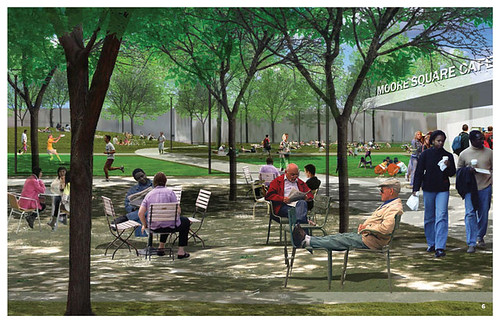
Chris Counts Studio 7 (Via Flickr)
In the summer of 2009, the city ran a few open call workshops to get feedback from residents and interested groups about the idea of making changes to Moore Square, both in the square’s design and its use. After the three meetings, all the comments received can be described as:
Attendees value openness, activity, and versatility. They also want simplicity, diversity of people, and safety. Making it accessible and interesting to everyone – adults, children, youth, people with disabilities, and elderly – is a value shared by all. Many suggested making it a place for kids since the population of families in Raleigh continues to rise……
If you would like to read more comments, raw and un-edited, go to the city’s website here.
After all this input, the city started a design competition in order to better engage the design community to help drive the accessibility, diversity, and sustainability goals that came from the public feedback. Their hopes were for someone to create a space that would:
– Create a unique public space and urban experience for the 21st century;
– Engage broad public participation throughout the process and in the future; and
– Establish the conditions to develop a sustainable economic development strategy for the Moore Square area.
In the Fall of 2009, the winner and finalists were announced. Chris Counts Studio of Charlottesville, VA won the competition and their final design can be seen here on Flickr. If you would like to see some of the other submitted entries of the competition, they are here.
What’s next?
The open ideas have been recorded and the design competition is in the books. The next step is to draft a master plan for the square based on the winning design and public feedback. This starts in August with various community representatives meeting with the design team. Those reps will be part of a Public Leadership Group (PLG) and the Downtown Living Advocates will be represented by me in those meetings over the next several months. The focus of these meetings will be to get your input into the master plan for Moore Square. Once the plan has been finalized, it will go up for review, approval, and then adopted in the future.
I’d like to ask for comments from anyone, DLA member or not, about what they think about the design and what questions they have about the future Moore Square. Please comment on this post so we can get a conversation started or e-mail me anytime at Leo@DTRaleigh.com.
Also, consider joining the Downtown Living Advocates if this topic and other future plans in downtown Raleigh interest you.

 Age distribution based on DLA’s over 450 Facebook Fans
Age distribution based on DLA’s over 450 Facebook Fans





